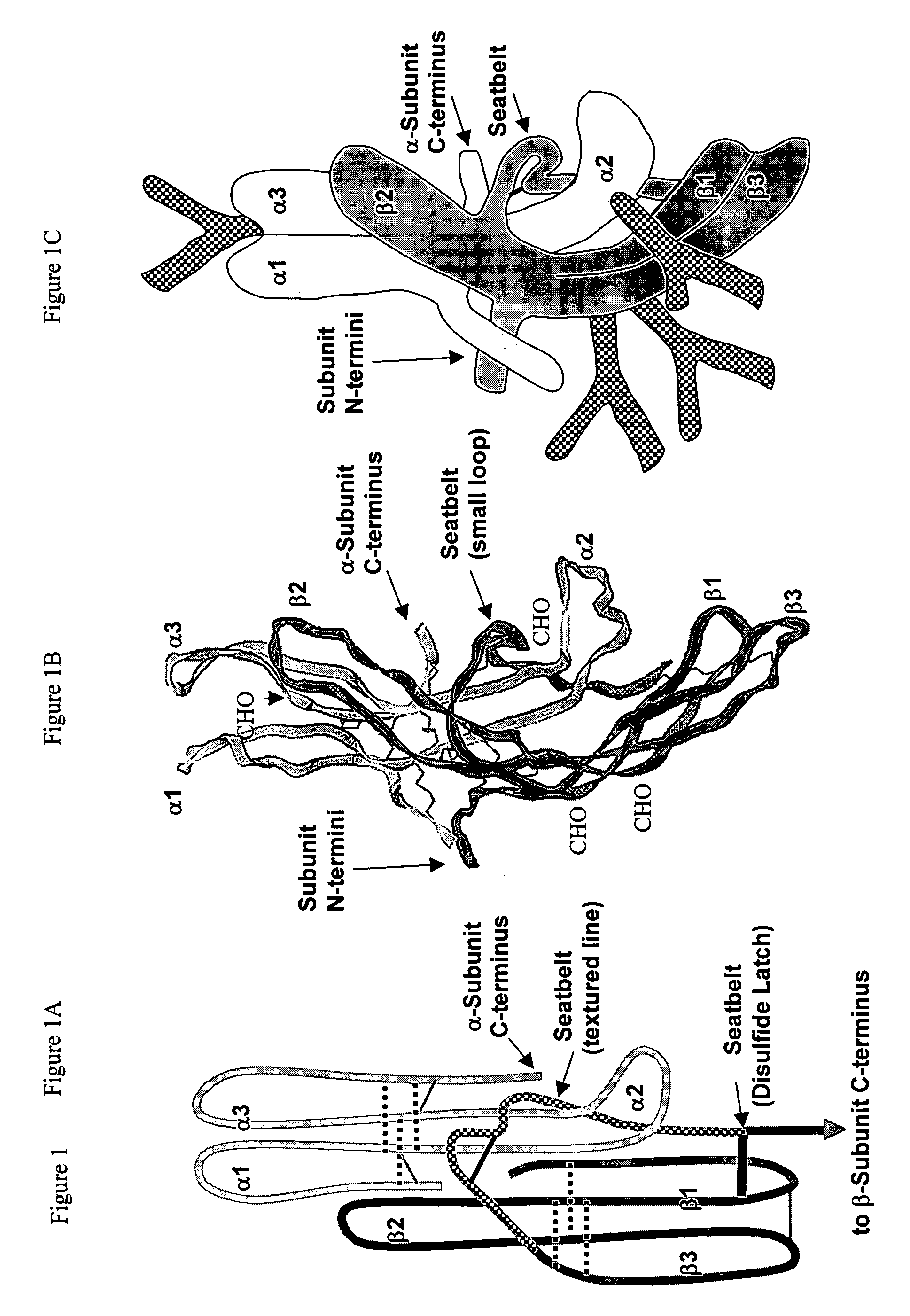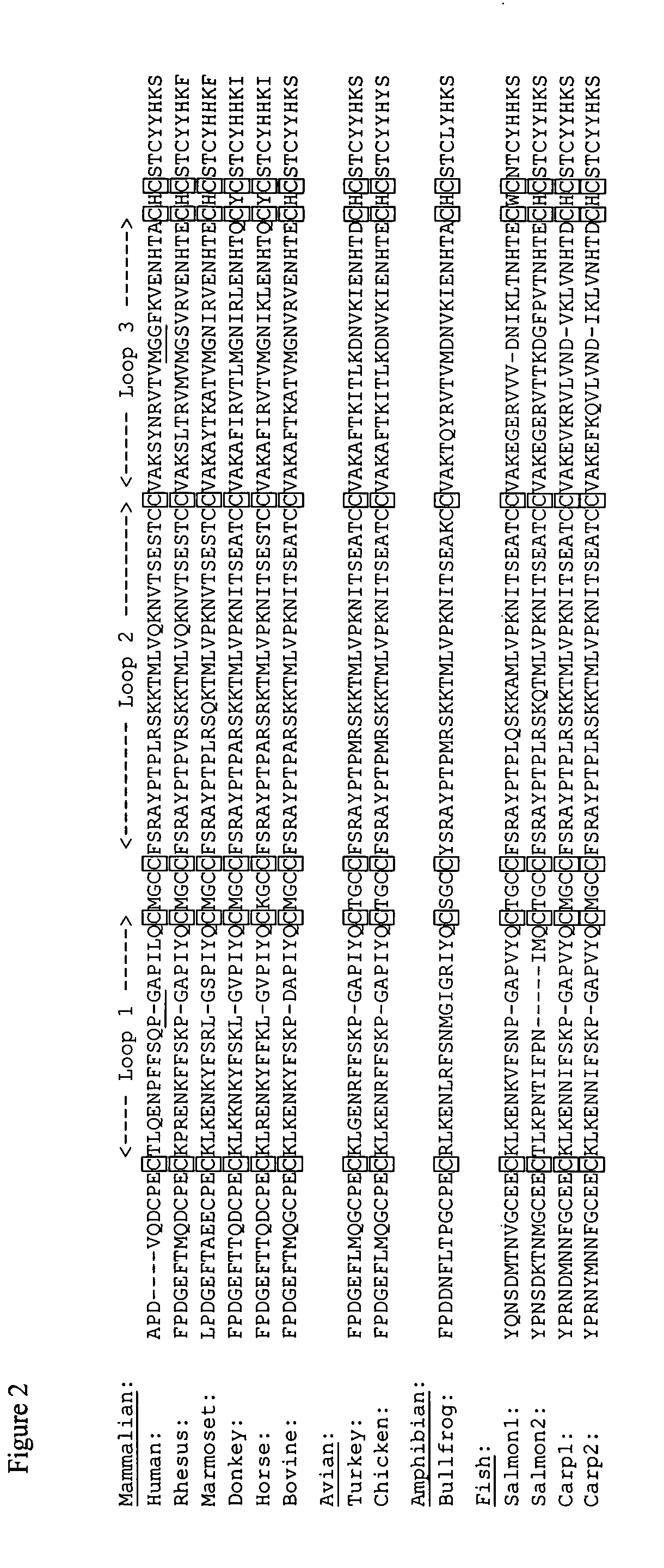Low efficacy gonadotropin agonists and antagonists
a low-effect, gonadotropin technology, applied in the direction of growth hormones, peptide/protein ingredients, drug compositions, etc., can solve the problems of reducing fertility, ovarian hyperstimulation, surgical methods with risks associated with surgery, etc., to reduce the ability to elicit signal transduction, promote chemical wedge resection, and reduce its efficacy
- Summary
- Abstract
- Description
- Claims
- Application Information
AI Technical Summary
Benefits of technology
Problems solved by technology
Method used
Image
Examples
example 1
Effect of Removing the α-Subunit Loop 2 Oligosaccharide on hCG Activity
[0060] Most efforts to prepare human choriogonadotropin (hCG) and follitropin (hFSH) antagonists involve removing their N-linked oligosaccharides, a component of these hormones required for full efficacy. The N-linked oligosaccharide on α-subunit loop 2 (α2) has a dominant influence on efficacy and an hCG analog lacking this oligosaccharide had 40% the efficacy of hCG in cyclic AMP accumulation assays. This oligosaccharide is located at the subunit interface and may contribute to efficacy by influencing the conformation of the heterodimer. As outlined here, the residual efficacy of hCG analogs lacking the loop α2 oligosaccharide can be reduced by constraining the conformation of the heterodimer with intersubunit disulfide bond cross-links.
[0061] hCG was purified in this laboratory as described (Bahl, 1969) or obtained from Dr. Robert Campbell (Serono Research Institute, Rockland, Mass.). Analogs of the α-subuni...
example 2
Influence of Intersubunit Disulfide Bonds on hCG Activity
[0063] Constructs that encoded the analogs described here were prepared by standard methods familiar to those skilled in the art of site directed mutagenesis and were similar to those described earlier (Moyle, Matzuk, Campbell, Cogliani, Dean Emig, Krichevsky, Barnett, and Boime, 1990). Their amino acid sequences are identical to that of the hCG α- and β-sequences except as indicated in Table 1 and in FIGS. 5 and 6. The analogs were (Cosowsky, Rao, Macdonald, Papkoff, Campbell, and Moyle, 1995; Moyle, Campbell, Rao, Ayad, Bernard, Han, and Wang, 1995) expressed transiently in COS-7 cells, also as described earlier (Campbell, Dean Emig, and Moyle, 1991). Material secreted into the medium was assayed by sandwich immunoassay as described (Moyle, Ehrlich, and Canfield, 1982), except that α-subunit antibody A113 was used for capture and β-subunit antibody B110 was used for detection. As noted earlier, other antibodies could have b...
example 3
Influence of Modifying the Seatbelt
[0066] The finding that some but not all intersubunit disulfides could reduce the efficacy of hCG suggested that the conformation of the heterodimer may have a key role in its ability to elicit a hormone response. This possibility was tested by modifying the seatbelt, a portion of the hormone that had been shown to influence the conformation of the heterodimer (Wang, Bernard, and Moyle, 2000). As expected on the basis of previous studies (Moyle, Campbell, Myers, Bernard, Han, and Wang, 1994), substitution of hFSH residues into this region of the seatbelt did not prevent the analog from binding to LH receptors (FIG. 9A) and enabled it to interact with FSH receptors (FIG. 9C). The abilities of dgα37-β33CF and dgα37-β33CFC to block binding of 125I-hFSH to FSH receptors was greater than that found for other bifunctional analogs (Moyle, Campbell, Myers, Bernard, Han, and Wang, 1994). The presence of the FSH residues reduced the efficacies of dgα37-β33C...
PUM
| Property | Measurement | Unit |
|---|---|---|
| Mass | aaaaa | aaaaa |
| Mass | aaaaa | aaaaa |
| Mass | aaaaa | aaaaa |
Abstract
Description
Claims
Application Information
 Login to View More
Login to View More - R&D
- Intellectual Property
- Life Sciences
- Materials
- Tech Scout
- Unparalleled Data Quality
- Higher Quality Content
- 60% Fewer Hallucinations
Browse by: Latest US Patents, China's latest patents, Technical Efficacy Thesaurus, Application Domain, Technology Topic, Popular Technical Reports.
© 2025 PatSnap. All rights reserved.Legal|Privacy policy|Modern Slavery Act Transparency Statement|Sitemap|About US| Contact US: help@patsnap.com



